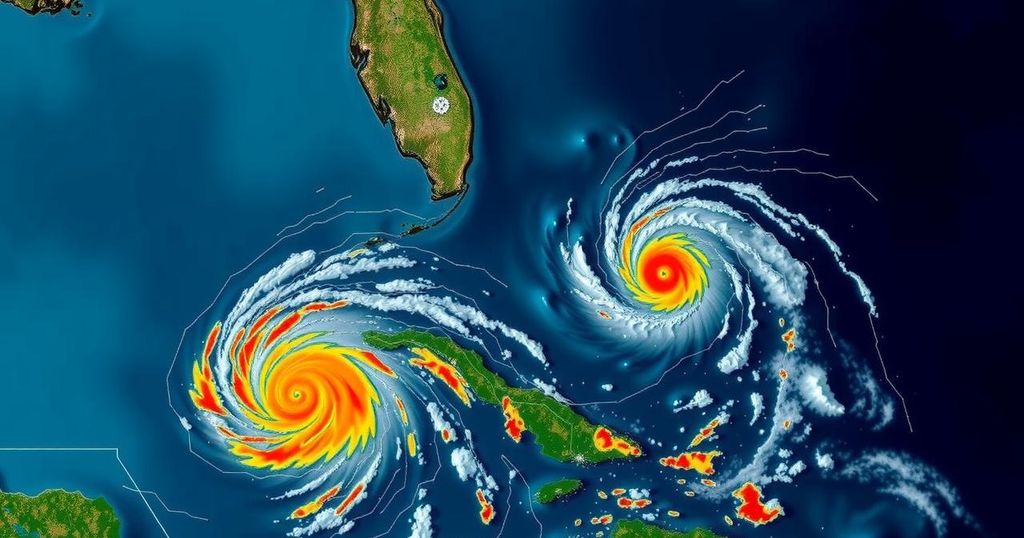In November, Florida has historically experienced three hurricanes: an unnamed hurricane in 1935, Hurricane Kate in 1985, and Hurricane Nicole in 2022. With the potential arrival of Hurricane Sara, history may repeat itself as it could become the fourth hurricane to impact Florida this month. Warm ocean temperatures contribute to this unusual late-season activity, provoking discussions on climate change and hurricane preparedness.
In recent developments surrounding hurricanes impacting Florida, it has been noted that a new storm in the Caribbean is likely to be named Hurricane Sara, with the potential for landfall in Florida next week. Should this occur, it will mark the fourth hurricane affecting the state in a single season, with the previous storms this year, namely Helene and Milton, being classified as major hurricanes. This would represent a rare occurrence; historically, only once before, in 2004, have three major hurricanes made landfall in Florida in the same year. Furthermore, if Sara does impact Florida, it will only be the fourth hurricane to make landfall in the state during November, a month that typically experiences cooler ocean temperatures unfavorable for hurricane development. Historically, there have only been three hurricanes that have struck Florida in November: an unnamed hurricane in 1935, Hurricane Kate in 1985, and Hurricane Nicole in 2022. Additionally, in recent records, only five hurricanes have impacted the continental U.S. in November over the past 173 years. The warm ocean temperatures this season remain above the typical range expected during this time, thereby increasing the likelihood of tropical storm formations, as noted by experts in the field. To provide further context, Hurricane Nicole made landfall as a Category 1 storm on November 10, 2022, having sustained winds of 75 mph. Hurricane Kate, which landed near Mexico Beach in 1985, reached a peak strength of Category 3 with winds up to 120 mph. The earliest of the three, the Yankee Hurricane of 1935, registered as a Category 2 storm at landfall north of Miami Beach. Additionally, it is pertinent to mention that nine tropical storms have also made landfall in Florida during November over the years, though they did not reach hurricane status. Moreover, several notable hurricanes in November did not strike the U.S. as hurricanes. For example, Hurricane Eta achieved Category 5 strength in 2020 but weakened before reaching Florida. Similarly, Hurricane Ida in 2009 and Hurricane Paloma in 2008 caused significant damage in other regions before losing strength, and Hurricane Lenny in 1999 became notably known for its unusual west-to-east path. Typically, the Atlantic hurricane season extends from June 1 through November 30; however, storms can develop beyond this time frame, indicating an increased risk of hurricanes impacting Florida due to changing oceanic conditions.
Understanding the frequency and impact of hurricanes in Florida, particularly in late November, requires an examination of historical data and ocean temperature trends. Hurricanes historically land in Florida during peak hurricane season, which typically runs from June 1 to November 30. However, warm sea surface temperatures may extend the season’s activity, leading to unusual late-season storm events. Additionally, historical records indicate that Florida has only experienced a few hurricanes making landfall in November since comprehensive records began. The study of these trends offers insight into changing climate patterns and the rising likelihood of more hurricanes occurring outside the established season. As ocean temperatures continue to warm, it may lead to increased storm activity, emphasizing the need for continued research and preparedness among coastal communities. The statistical significance of major hurricanes making landfall in a single season is also of interest to meteorologists and disaster response teams alike.
In summary, Florida has recorded three hurricanes that directly impacted the state during November since tracking began. With the notable potential for Hurricane Sara to make landfall soon, Florida could be facing an unprecedented increase in hurricane activity for this late in the season. The phenomenon highlights the effects of warmer ocean temperatures on hurricane trends, suggesting an increased risk of tropical storms extending beyond the typical hurricane season. The historical significance of this year demonstrates the pressing need for awareness and preparedness in dealing with hurricane threats.
Original Source: www.heraldtribune.com






